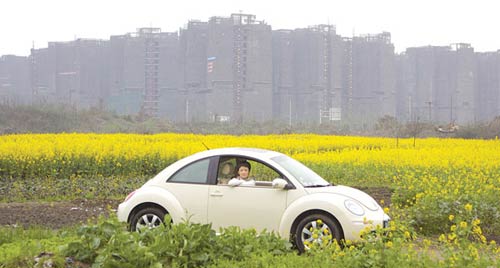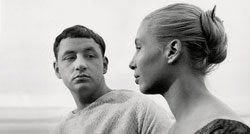
I’ve realized over the last couple years that sold out doesn’t always mean sold out at TIFF, and I’m not just talking about the possibility of rush lines. Tickets are reserved in advance for publicists and other festival guests, but obviously not all of those seats are needed. So often by the fourth or fifth day, when TIFF has a better perspective on what it requires, it releases more tickets. Furthermore, the lines to exchange tickets are often significantly lighter by Monday than they are over the weekend. So today I walked into the box office at 9 a.m., strode confidently to the open agent, and proceeded to get all four movies for which I had been shut out of in the lottery. Woo hoo!
The morning just keeps getting better when I meet up with Ken Morefield for a delicious breakfast at Cora’s, which includes lots of discussion about college teaching, academic writing, and of course movies. And then we’re off to one of the more difficult films of the fest. But I’ll save that for the end.
The Chinese director Jia Zhang-ke made one of my favorite films of the decade with Still Life/Dong. Though those are two different movies, I saw them both at TIFF ’06, and their similar subject matter makes them a natural pairing. He followed that up with last year’s Useless, which was interesting and well made but didn’t scale anywhere near the heights of his previous work. Even still, I had high hopes for his latest, 24 City.
It’s a documentary about a Chinese military factory in the city of Chengdu in the southwest part of the country. The factory is being shut and torn down to make way for upper-end apartments in this fast-growing city, and Jia captures both the factory and several of the people who worked there.
The material makes it sound like Still Life, which focused on the towns being leveled to make way for the Three Gorges Dam. But 24 City is much more traditional, with long sections devoted to workers telling their stories: how many of them came from Shanghai or other faraway places, how younger workers grew up in Chengdu and what that was like, and how economic modernization has taken its toll on people caught in the middle. The one unusual element here is that Jia has cast several well-known Chinese actors (including Joan Chen) to read some of their stories. But I’m not quite sure how that postmodern touch actually “works†in this film (besides the obvious fact/fiction motif), especially when one of its themes is not to waste what’s older.
My favorite parts of 24 City are when Jia takes his camera out of the interviews and instead shoots what’s going on. Early scenes of masses of workers are stunning, and Jia has a way of capturing decay that makes it seem incredibly rich and beautiful. I also like the playful touches: a man talking about the building of a factory while two men play badminton on the stage behind him, a young girl roller skating in circles on a roof. And the movie is certainly thoughtful about how today’s modernization has roots in earlier times, and it doesn’t sentimentalize factory labor as some sort of worker’s paradise.
But I had a similar reaction to 24 City that I had to Useless. I’m thrilled that Jia is documenting his country’s incredibly rapid modernization, but I wish he’d slow down his own output--instead of making a film every year, how about every two years? That way he could go into the depth that both his material and skill deserve. By coming out with film after film, he seems to have skimmed along the surface (though a beautiful surface it is) rather than create the deep, brilliant works that he has in the past.
La Pointe Courte was Agnes Varda’s debut. As she admitted in the Q&A afterwards, she not only knew very little about making movies back in 1954, she hadn’t seen many films. That lack of background, as well as her photography experience, meant that she wasn’t bound by traditional film style, and it shows in this striking black-and-white feature.
The movie is about a traditional fishing village and the modern Parisian couple who come to visit. Those two aspects--village life and modern romantic ennui as only the French can do--sit uneasily next to each other, as Varda alternates back and forth. How much you enjoy Pointe Courte depends somewhat on how much you enjoy hearing a couple talk endlessly about their situation, though Varda livens things considerably with genuinely unusual and beautifully high-contrast compositions. One scene in the hull of a boat is both spectacular and metaphorically dense. Still, I agree with Varda’s delightful post-film comments that the sound is awkward, as are some of the performances. La Pointe Courte is an interesting debut, particularly put in the context of Varda’s later work, but it’s not a total success when seen alone.
Samira Makhmalbaf’s Two-Legged Horse has a difficult premise. A relatively wealthy Afghan man wants to hire a poor boy to carry his crippled son around. The movie doesn’t get any easier, as Makhmalbaf portrays how the richer boy slowly and brutally dehumanizes the poorer one, eventually turning him into a horse.
If that reminds you of a Kafka story, it should, as Makhmalbaf leaves the realm of realism and enters full-blown allegory. We see that in the very first image, a truly amazing long shot of people scurrying out of underground hovels like so many little bugs. This continues in powerful scene after powerful scene. Her use of montage editing is particularly impressive. One scene of the two boys in the midst of real horses and riders is paired with what sounds like a familiar film score (though I couldn’t place it), and the way the film cuts to the music is incredible. Another montage strings several tracking shots together in a way that wouldn’t work nearly as well if it was just one long take.
I was also struck by the compositions in the film, how Makhmalbaf and cinematographer Farzad Jodat vary the camera placement and angle. Sometimes low, sometimes high, but always provocative. The use of light is also important, as she varies bright and dark in important ways.
I freely admit that images are different than words, especially film images, and so the unquestionably difficult scenes have a greater force here than in, say, a story like Kafka’s “The Hunger Artist.†Furthermore, Makhmalbaf does push a few moments further than necessary, though I’d argue that the extremity of the rich boy’s behavior is critical to both establishing the allegory (we’re not in neo-realist land anymore) and emphasizing its connection with the violence of rich against poor in our world. Still, I understand that many festivalgoers had no idea what they were getting into, and subjecting them to this at 12:30 p.m. was a bit much.
With all those qualifications, though, Two-Legged Horse strikes me as a compelling allegory of our contemporary world. A world in which women by the hundreds of thousands are sold into sexual slavery every year, when even more children are in bondage and working 16 hours a day, when corporations and the wealthy (empowered by our pension and 401(k) plans) are abusing labor around the world, and when the rich use the poor for their own amusement. I thought the allegory might run thin quickly, but Makhmalbaf finds new uses for it, new ways to comment on our society. Difficult yes, but also incredibly thought-provoking.
If someone understands the distinction between allegory and realism and still questions the movie’s brutality, it’s akin to someone reading “The Metamorphosis†and asking, “Why is he a bug?â€
Tomorrow is another five-film day and a most satisfying one.






I am baffled that you defend Two-Legged Horse while considering Salamandra "loathesome." I found this movie loathesome, despite some beautiful cinematography, poetic touches, and heavy-handed allegory. If it had ended at the graveyard sequence where the half-limbed boy asked the half-witted one to pour water on his lost legs, I might have respected the film and left with some measure of feeling. As it is, by film's end, I detested both children for their sadomasochistic co-dependency. Whatever poetry might have been achieved in the film (I liked that the half-witted boy loved flying birds as much as he loved the girl with flying birds on her skirt), said poetry was undermined by a complete lack of economy.
Frankly I am also amazed that you would defend this film so much. It is no surprise that the director did not take questions at the end of the film either in Toronto or in Abu Dhabi (where I watched the film).
While the film had beautiful cinematography and a potentially interesting premise. It was clumsy, overly repetitive (to the point of monotony) and poorly structured. There were plenty of powerful scenes but they didn't seem to hang together with any real sense of structure.
The last 30 minutes of the film especially becomes a series of disparate and increasingly bizarre set pieces which don't seem to have any relation to each other, aside from trying to shock and heavy handedly attempting to hammer home the allegorical points. She is obviously assuming the audience didn't get the point in the first hour.
The strangest - and most out of place being the cruel game being played about an hour in. It appeared to be shoe-horned in for no real reason (other than it is a literal, rather than allegorical episode of abuse and cruelty - which kind of defeats the object of an allegorical film no??)
It is allegorical, yes we get it. Rich exploits the poor (both geo-politically, locally, globally - yes we get it. The disadvantaged get exploited and abused by the powerful, yes we get it. Women are exploited, yes we get it. We don't need to be beaten over the head repeatedly with a blunt object to understand the point.